The History Of FORD Explorer

The Ford Explorer is a mid-size sport utility vehicle sold in North America and built by the Ford Motor Company since 1990. It's manufactured in Louisville, Kentucky (it was also assembled in Hazelwood, Missouri until the plant closed on March 10, 2006). The Ford Explorer was instrumental in turning the SUV from a special-interest vehicle into one of the most popular vehicle types on the road.
The Explorer has also been involved in controversy, after a spate of fatal rollover accidents involving Explorers fitted with Firestone tires.
Both two-door Explorer Sport and four-door models of Explorer have been sold. Part-time four-wheel drive is an available option, and since 1995 this has been a 'shift on the fly' system with full protection against being engaged at high speed.
A specially modified Special Service Vehicle version is also available from Ford Fleet for law enforcement.
Explorer was also the name of a trim package offered on the Ford F-Series trucks from 1968 to 1986.
The Ford Explorer Sport was a 2-door version of the Ford Explorer, designed to take the place of the Bronco II in Ford's model line, and was produced from 1991 to 2003. The Sport began as a trim level of the Ford Explorer, but it eventually became its own model. It rode on a 10" shorter wheelbase. There was only one Sport, but there were several other trim levels of the Explorer that were available with 2 doors(edmunds trim levels), such as the XL (1991-1997), the Eddie Bauer (1991-1994), and the Expedition (1995). In 1998 the Explorer Sport became the only 2-door trim level of the Explorer, and in 2001 it became its own model, as the second generation Explorer moved on to a 4-door-only 3rd generation.
The Ford Explorer was released in March 1990 as a 1991 model. It was equipped with a 4.0L 155hp (116kW) V6 engine and 4-speed A4LD automatic transmission or 5-speed M5OD manual transmission. Like the Ford Bronco II it replaced, it was an SUV derivative of the Ford Ranger Pickup, but larger. Following the Chevrolet S-10 Blazer, it came in both 2-door and 4-door bodystyles. It was available with rear or four-wheel drive. The four-wheel drive versions came with a Borg Warner 13-54 part-time four wheel drive transfer case. The 13-54 was available with "Touch Drive" electronic push button shifting as well as manual, lever operated shifting. Both designs were "shift-on-the-fly" designs that allowed the truck to be shifted from two wheel drive to 'four-high' at any speed. All Explorers came with the 8.8" Ford rear axle in either a limited slip or open version with a variety of available gear ratios. Explorers came in 4 trim levels: base XL, XLT, Sport (only available on the two-door version), and the upscale Eddie Bauer Edition. 15hp (11kW) was added for 1993 for a total of 170hp (119kW). The Limited edition, added for 1993, was available only in the 4-door style and was even more upscale than the Eddie Bauer version. It featured automatic headlights, foglamps, an automatic transmission as standard equipment, an auto-dimming rear view mirror, a center roof console with compass and outside thermometer, special wheels, and a special grille.
Technically similar to the original Ford Explorer, the Explorer Sport came in both rear-wheel drive and four-wheel drive variants. It replaced the 2-door Ford Bronco II, and was larger than the Bronco II. A variant of the Explorer Sport was sold by Mazda as the Navajo, which won Motor Trend's Truck of the Year award but was discontinued in 1994.
Common complaints about the first generation models mostly came from the A4LD automatic transmission. Towing wasn't its strong point and it couldn't handle much more power if the engine saw any aftermarket upgrades. Also, problems came from the automatic locking front hubs. Moderate off road driving would destroy the plastic internals and leave the SUV stuck in 2WD. Manual locking front hubs did not suffer from reliability problems.
The Explorer saw significant exterior, interior and suspension updates in 1995. The former "Twin Traction Beam" (TTB) front suspension was replaced with a more carlike independent front suspension. The Explorer lineup now consisted of two models: 2-door Explorer Sport and the 4-door Explorer. The Limited was a higher end 4-door. A 210hp (157kW) 5.0L Windsor V8 engine and heavy-duty 4-speed 4R70W transmission were added for 1996, along with a "full time" all-wheel drive system on the Eddie Bauer and Limited in 1997. A more-powerful SOHC 205hp (153kW) engine came as an option in 1997 along with an optional 5-speed automatic. A Mercury twin, the Mountaineer, was added in 1997 as well. In early 1997, the 5.0 L received new cylinder heads (GT-40P series), which upped power to 215hp (160kw). Since this change was made in the middle of the 1997 release, the 1997 GT-40P equipped Explorers and Mountaineers were dubbed 1997¼ models.[citation needed] The 5.0 L V8 powered Explorer has become favored in the high performance SUV crowd, with many performance parts available. This is due to the fact that many aftermarket 5.0L Ford Mustang parts are interchangeable with the Explorer variant. Also, the Explorer has aftermarket parts available for it including superchargers, nitrous kits, and headers.
The 1995 Explorer was the first production vehicle to use a neon center high mount stop lamp.[citation needed] This was replaced with a more conventional lamp when the liftgate was refreshed in 1998. A slight change in front end design came in 1999, at which time the XLS name replaced XL as the base model.
Like the basic Explorer, the Explorer Sport was significantly updated in 1995. The Eddie Bauer trim level was replaced with Expedition on 2-door Explorers (1995 only, the name would be reused on the 1997 Ford Expedition). The rear was given a face lift for 1998.
2001 also saw the introduction of the Explorer Sport Trac, which put a small pickup bed behind the four normal SUV doors.
The 4-door Explorer and companion Mercury Mountaineer were redesigned entirely in 2002, losing all design similarity with the Ranger and the still in production, second generation inspired Explorer Sport Trac. Engines were either the 210hp (157kW) SOHC 4.0L V6 with 254ft·lbf (344N·m) of torque or a 239hp (178kW) 4.6L V8, with the 203hp (151kW) 4.0L still available on the Explorer Sport. A third-row seat became available for the first time, bringing total passenger capacity to seven. Both manual and automatic transmissions and all-wheel drive were available (with 2002 being the last year of being able to order a 4-door and manual transmission). Trim lines were the base Sport Value, Sport Choice, XLS, Sport Premium, XLT, Eddie Bauer, and top Limited. AdvanceTrac with Roll Stability Control were standard for 2005 but an option from 2002 and on.
All three SUVs use code U6 (for rear-wheel drive), U7 (for four-wheel drive), and U8 (for all-wheel drive) in the 5th, 6th, and 7th positions of the VIN.
When the Explorer was redesigned for 2002, the Explorer Sport continued unchanged for 1 more year. Due to the decline of 2-door SUVs, the 2-door Explorer Sport was discontinued in 2003.
Intake manifold defect
Certain 2002 V8 Explorers, using an all-composite intake manifold, are subject to coolant leaks. Late in 2005 Ford settled a class action lawsuit. See Intake Manifold Defect for details.
The Explorer and Mountaineer were updated for 2006 on a new frame, produced by Magna International rather than Tower Automotive. It was upsized, because the Ford Freestyle (now called Ford Taurus X), slotted between it and the Escape. Along with this new, stronger base were a new interior, redesigned rear suspension, and power-folding third-row seats. A tire-pressure monitoring system and electronic stability control are standard. Power running boards (like those on the Lincoln Navigator) that lower to allow easier to access for someone entering the vehicle and then later retract upon door closure are available. Unlike previous Explorers, there will be no right-hand drive version. Ford Australia has a capable local equivalent instead, being the Australian designed and developed Ford Territory. The new Explorer is marketed in Japan in a left-hand drive configuration, as LHD vehicles are considered prestigious there.
A 210hp (157kW) 4.0L V6 is the base engine, with the 292hp (218kW) 24-valve V8, similar to the Mustang engine, as the top choice. A six-speed automatic transmission is available with this engine as well.
The Explorer was nominated for the North American Truck of the Year award for 2006.
A new Sport Trac was added to the Explorer line in early 2006 for the 2007 model year. Unlike its predecessor it sold through 2005, it will feature the V8 engine as an option, and will be based on the new, larger Explorer platform. AdvanceTrac with Roll Stability Control will be standard in the Sport Trac.
A special 2007 SVT model called the Sport Trac Adrenalin was to use a supercharged version of the 4.6L Modular V8, with 390hp (291kW) and featuring 21-inch (530mm) wheels. It was to be a successor to the F-Series Lightning pickup. However, it was cancelled in a cost-cutting move, as part of The Way Forward.
Ford has revealed in media press releases, along with a gallery of photographs, a new Explorer America concept vehicle, scheduled for public unveiling at the 2008 North American International Auto Show. The concept represents a new design direction for a future, more fuel efficient Explorer. The Explorer America concept is built on a unibody platform to reduce weight and improve driveability, migrating from the body-on-frame platform of the current Explorer. It is designed for up to six passengers, and can tow 3,500 pounds, while improving fuel economy by 20 to 30 percent relative to the current V6 Explorer. The powertrain packages in the concept vehicle include a two-liter four cylinder turbocharged direct injection EcoBoost gas engine with 275horsepower (205kW) and 280ft·lbf (380N·m) of torque, and a 3.5 liter V6 version EcoBoost with 340horsepower (250kW) and up to 340ft·lbf (460N·m) of torque. The EcoBoost engine is scheduled for initial installation in the Lincoln MKS sedan in 2009, followed by the Ford Flex and other vehicles, and is expected to power a half-million Ford vehicles each year by 2013. Ford is also looking into using lighter weight chassis components with materials such as aluminum and magnesium, and electric power steering to reduce weight, along with improved aerodynamics, to improve fuel economy in the Explorer and other vehicles. Ford has confirmed that the Explorer will make the switch to a car based platform sometime around 2010 or 2011.[citation needed] Many Ford purists are disappointed by this fact, claiming that it is the end of the Explorer as America knows it. Spy shots have circulated the internet and the testing model has a body similar to the Ford Taurus X. The new Explorer will replace the Taurus X.
To compete with other police SUVs that are sold by other automobile companies, Ford has made a special package for the Explorer that's only available to law enforcement agencies, fire departments, and EMS agencies. Ford calls it the Explorer Special Service Package. The only differences between the standard Explorer and the Special Service Package Explorer are provisions for emergency services related equipment such as radios, lightbars and sirens. There are also options designated fleet only (such as custom 2 tone paint arrangements) that are available to the Explorer Special Service Package.
With the introduction of the second generation Explorer in 1995, Ford attempted to market the Explorer in the UK, similar to the Taurus Ghia, Ford's attempt to market the Taurus in Australia and New Zealand. The Explorer was poorly received in the UK, apparently in large part because it was designed for comfortable city cruising, rather than off road capability. Many UK buyers only bought SUVs if they needed cargo flexibility or off-road capability, and they viewed large SUVs as less of a family car, as opposed to station wagons, which are more traditional British family haulers. That meant that UK SUV buyers largely stuck with Land Rovers or Jeeps. After the Firestone tire problems (see below), Ford withdrew the Explorer from the UK market.
Second Generation UK Models. In the UK the Ford Explorer was initially available as just one model, with the 4.0litre engine and with a high specification - the only dealer options being leather interior. In 1998, a facelifted Explorer was available with minor cosmetic interior changes and a revised rear tail lift which centered the rear number plate. In 1999 the model range was revamped slightly, the base model becoming the XLT and a special edition North Face version marketed with a tie in to North Face outdoor clothing. The North Face version was available in a dark green or a silver, with body coloured bumpers, heated leather seats and a CD multichanger as standard. In 2000, the North Face was also in black, which is a very rare sight on UK roads.
Second Generation UK Model Problems. The UK versions suffer from the same timing chain problems the US versions did, but were not subject to a recall. Its essential to maintain and monitor the timing chain tensioner if it is still the original plastic one.
Current Exports As of 2008, the Explorer is exported to Canada, Mexico, Japan, South Korea, Israel, Russia, Iceland, the Middle East, and certain countries in South America and Africa.
A large number of companies are suppliers for materials and parts that make the Ford Explorer. Suppliers include Johnson Controls, Magna International, Lear Corporation, Dana Corporation, and Visteon.
Rollover and Firestone Tire Controversy
Main article: Firestone vs Ford Motor Company controversyIn May 2000, the National Highway Traffic Safety Administration (NHTSA) contacted Ford and Firestone about a higher than normal incidence of tire failures on Ford Explorers, Mercury Mountaineers, and Mazda Navajos fitted with Firestone tires (later including Ford Ranger and Mazda B-Series pickup trucks). The failures all involved tread separation— in which the outer tread carcass would delaminate and cause a rapid loss of tire pressure. Ford investigated and found that several models of 15 in (381mm) Firestone tires (ATX, ATX II, and Wilderness AT) had higher failure rates, especially those made at Firestone's Decatur, Illinois plant.
Ford argued that Firestone was at fault. Ford's argument noted that its SUVs and pickups equipped with Firestone-competitor Goodyear tires experienced no rollover issues, even at low psi levels. Since most Explorer, Mountaineer, Ranger, B-Series, and Navajo tires have been replaced, the rollover reports have subsided, further lending credit to Ford's position that the design of its vehicles were not at fault. Although the Explorer having a manufacturer recommended inflation of only 26 PSI likely contributed to the tread separation problem by causing the tires to operate at higher than normal temperatures.
Part of the rollover issue was poor driver reaction to the tire blowout. When a tire blew, the driver experienced a large jerk and many drivers reacted by jerking the wheel in an attempt to regain control. This action causes a shift of the vehicle's weight, which results in the roll-over of the vehicle, especially when this occurs at higher speeds (many reports of roll-overs were of vehicles being driven at speeds of 70mph (110km/ h) and above). Larry Webster, a test-driver for Car & Driver magazine was able, in a test simulating dozens of tire blowouts, repeatedly able to bring a 1994 Explorer to a stop without a single rollover, even at speeds of 70 MPH. According to Forbes magazine, car experts and NHTSA claim that the vast majority of crash accidents and deaths are caused not by the vehicle, but by the driver, by road conditions or some combination of the two.
In response to Firestone's allegations of Explorer's design defects, NHTSA undertook a preliminary investigation and reported that further action was not required. Its conclusion was that Explorer was no more prone to rollover than other SUVs given their high center of gravity. The subsequent introduction and proliferation of electronic stability control systems have essentially addressed and mitigated this shortcoming.
In January, 2001, Ford Motor Co. and Bridgestone/ Firestone Inc. settled a lawsuit with a Texas woman, Donna Bailey, who was left paralyzed after a tire-related crash in an Explorer, averting a courtroom drama that would have focused attention on one of the nation's most serious highway safety investigations. The exact amount of the settlement was not disclosed, and the amount Ford and Firestone agreed to pay Donna Bailey has been sealed by court order. Hours before the settlement was announced, three senior Ford lawyers took the unusual step of visiting Bailey in her room at a Houston rehabilitation center in order to apologize. The case demonstrated Ford's heavy involvement in the deaths and injuries associated with the Ford Explorer and Firestone tire accidents, including the vehicle's role in causing accidents to occur. Bailey's attorneys, including Tab Turner, also reported as part of the settlement discussions with attorneys about expanding Firestone's recall of 6.5 million Firestone tires, since the tire involved in Bailey's accident was not one of those recalled. Consistent with the result, federal regulators in the fall of 2001 ordered a recall of the remaining Firestone tires. (Grimaldi, Washington Post, "Firestone, Ford Settle Tire Lawsuit", January 9, 2001)
U-Haul trailers
On December 22, 2003, U-Haul, the largest North American equipment rental company, announced that they would prohibit their outlets from renting trailers to persons planning to tow behind Ford Explorers due to liability concerns. This however was completely baseless by that time as the problem had been corrected with the tire recall, and the corrected inflation recommendation.[citation needed] Further, U-Haul did not alter their policies regarding the renting of trailers to persons planning to tow behind the Mercury Mountaineer, which is mechanically identical to the Ford Explorer.[citation needed]
From Wikipedia, the free encyclopedia
More About FORD Explorer
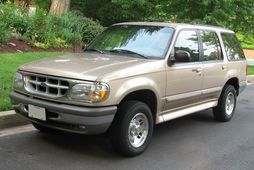
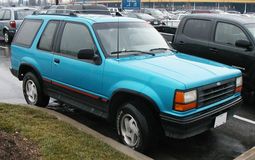
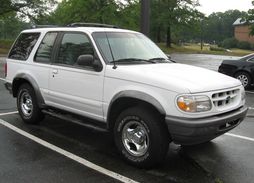
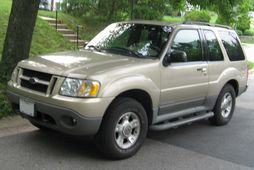
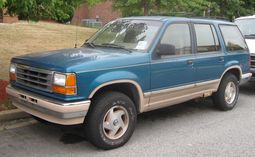
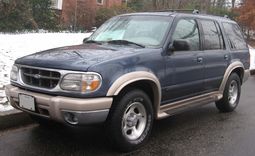
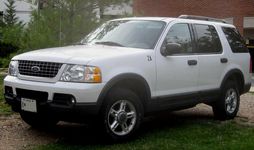
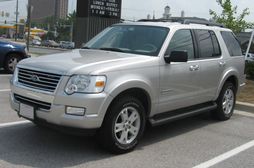
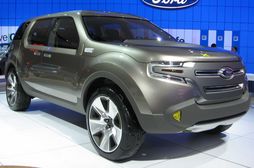
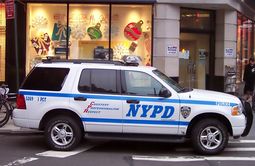
|